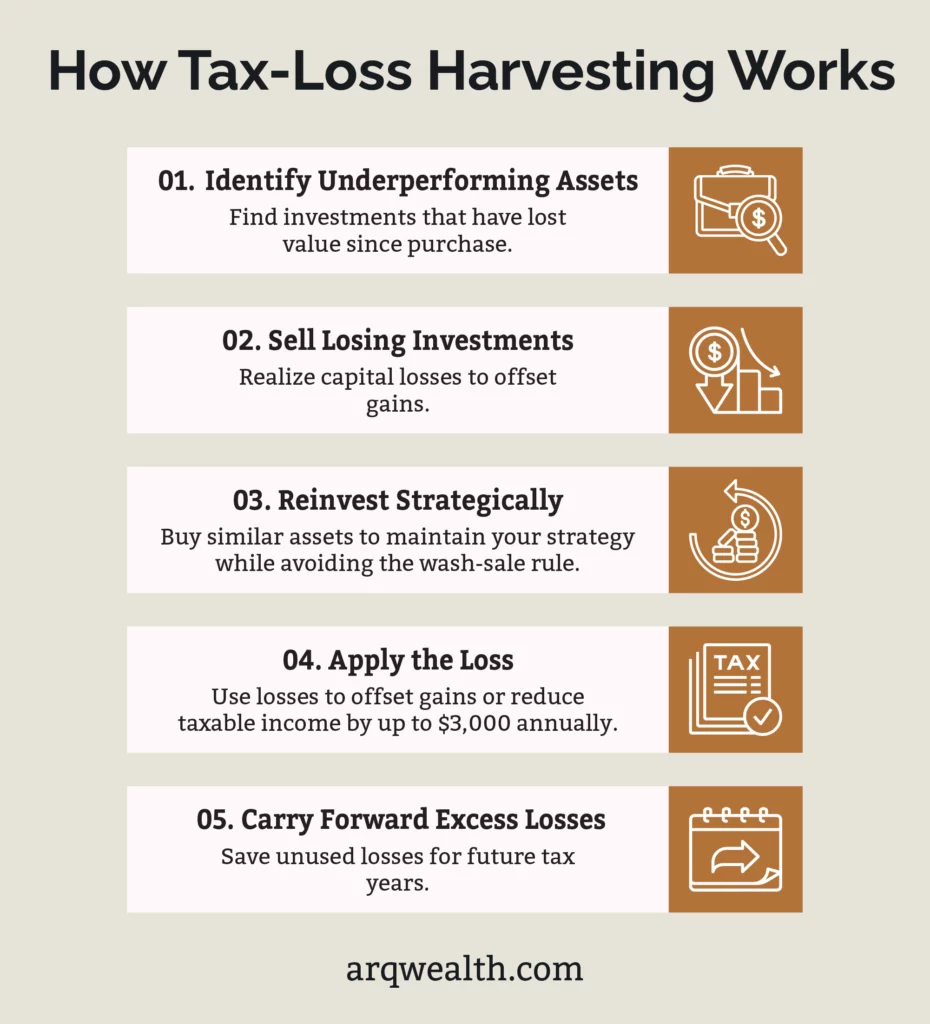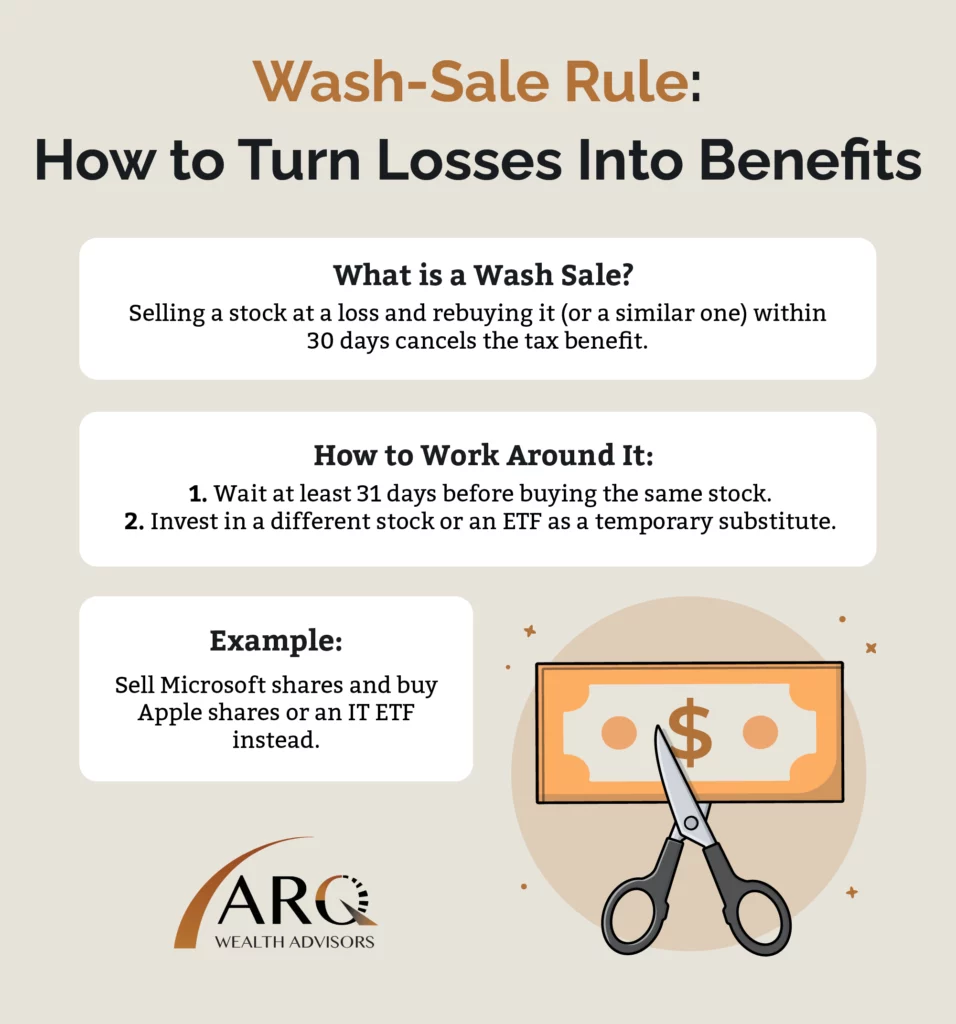Increasing volatility has caused many investors to be concerned about their exposure to the stock market. Even after an extended period of positive gains, investors still dread the potential for losses more than they celebrate the pleasure of gains—a cognitive bias known as “loss aversion.”
Loss aversion is a powerful and potentially destructive psychological tendency to avoid losses and be more risk-averse. Afflicted investors tend to ignore the historical perspective that shows how the market inevitably recovers from a downturn and eventually advances to new highs as it has done since its inception.
But what if losses didn’t have to hurt? What if a market downturn is an opportunity to boost portfolio performance? Welcome to the world of tax-loss harvesting.
Tax-Loss Harvesting: Making Lemonade out of Lemons
Tax planning is an essential component of wealth management, and one of the most effective strategies for optimizing one’s tax situation is tax-loss harvesting. This strategy is designed to lower investors’ tax liability by deliberately generating tax losses to offset taxable capital gains. Investors can sell securities that have decreased in value and use the capital gains they’ve realized from selling other investments at a profit to offset their tax liabilities and generate tax savings.
Losses can be used to offset up to $3,000 in capital gains. If your losses exceed your capital gains, they can offset up to $3,000 of ordinary annual income. Losses that exceed the $3,000 cap can be carried forward into future tax years.
By leveraging this approach, investors can reduce their tax burden while staying invested in the market to achieve their long-term financial objectives. Tax-loss harvesting is especially valuable during periods of market volatility when asset values may decline temporarily.
How Does Tax-Loss Harvesting Work?
Here is a step-by-step explanation of how tax-loss harvesting works:

- Identify underperforming assets: Review your investment portfolio to identify assets that have lost value since their purchase.
- Sell the losing investments: Sell the underperforming assets to realize a capital loss. This creates a tax benefit that can offset capital gains or other taxable income.
- Reinvest in a similar asset: Replace the sold investment with a similar but not “substantially identical” security to maintain your investment strategy and avoid the IRS’s wash-sale rule (explained below).
- Apply the loss: You can use realized investment losses to offset capital gains or ordinary income on your tax return.
- Carry forward excess losses: If your losses exceed your capital gains, they can be carried forward indefinitely to offset gains or income in future tax years.
The Wash-Sale Rule

One critical aspect of tax-loss harvesting is understanding the wash-sale rule. According to the IRS, a wash sale occurs when you sell a security at a loss and buy the same or a “substantially identical” security within 30 days before or after the sale. The initial sale then becomes “a wash,” and the tax benefit of the loss is disallowed.
However, if you wait 31 days to repurchase the stock, you run the risk that its price will increase significantly, making it a less attractive investment. You can avoid the wash sale restriction by replacing the sold stock with one that is not substantially similar. For example, if you sold shares of Microsoft and replaced them with shares of Apple, that would not be considered substantially similar.
Alternatively, you could purchase a “proxy” security, such as an information technology exchange-traded fund (ETF), as a temporary substitute for your Microsoft shares. You can sell the ETF after 31 days and repurchase your Microsoft shares.
What are the Benefits of Tax-Loss Harvesting?
Tax-loss harvesting can create significant tax benefits.
Per the tax code, investors are allowed to use up to $3,000 of capital losses annually to offset capital gains or ordinary income. Losses of more than $3,000 may be carried forward to future years. If you choose to repurchase the shares you sold, you can still own an investment with upside potential, sell it in the future, and benefit from a more favorable long-term capital gains tax.
To that extent, tax-loss harvesting can be considered a tax-deferral strategy, which can enhance your long-term investment performance. The longer you defer taxes on your investments, the better they will perform long-term.
For example, if you avoid paying $1,000 in capital gains taxes today and instead defer the tax for 20 years, you will benefit significantly from the power of compounding returns. Assuming an average rate of return of 7%, compounding annually, that $1,000 will be worth almost $4,000 in 20 years, earning you an extra $3,000 on the money you would have otherwise paid in taxes.
That tax deferral can continue beyond your lifetime as your assets are passed to future generations. Assets received by your heirs after your death are given a step-up basis, essentially wiping out capital gains earned during your lifetime.
Additionally, realizing losses can enhance portfolio performance by allowing you to rebalance your portfolio and ensure alignment with your long-term investment strategy. Equally important, it will enable you to maintain market exposure. By reinvesting in similar securities, you remain invested in assets you prefer so you can participate in potential growth opportunities.
Who Can Benefit from Tax-Loss Harvesting?
Tax-loss harvesting is most beneficial for investors in higher tax brackets who have significant taxable investment accounts. It’s particularly effective for individuals who:
- Have realized substantial capital gains during the tax year.
- Hold underperforming investments they no longer want in their portfolio.
- Are subject to higher federal or state income tax rates.
Tax-loss harvesting is primarily used in taxable accounts. It does not apply to tax-advantaged accounts such as IRAs or 401(k)s since gains and losses in these accounts are not subject to immediate taxation.
Steps to Implement Tax-Loss Harvesting
Follow these steps to effectively implement a tax-loss harvesting strategy:
1. Review Your Portfolio
Analyze your investment portfolio to identify securities with unrealized losses. Work with a financial advisor to assess whether selling these investments aligns with your broader financial goals.
2. Understand the Tax Implications
Calculate the potential tax savings by considering your capital gains, taxable income, and applicable tax rates. This will help you determine the strategy’s value for your specific situation.
3. Avoid the Wash-Sale Rule
Plan your trades carefully to avoid purchasing substantially identical securities within the prohibited timeframe. Consider reinvesting in ETFs or mutual funds as temporary substitutes.
4. Rebalance Your Portfolio
Use the proceeds from the sale to reinvest in similar securities that align with your investment strategy. This ensures you maintain your desired asset allocation and risk profile.
5. Document Your Transactions
Keep detailed records of all transactions to facilitate accurate tax reporting and compliance with IRS rules.
6. Consult a Professional
Tax-loss harvesting requires a thorough understanding of tax laws and investment strategies. Partnering with a financial advisor or tax professional can ensure you maximize the benefits while minimizing potential pitfalls.
Call ARQ Wealth at (480) 214-9572 to speak with one of our financial advisors and find out if tax-loss harvesting is possible for you.
Common Mistakes to Avoid
- Triggering the wash-sale rule: Accidentally purchasing substantially identical securities can nullify the tax benefits of harvesting losses.
- Ignoring transaction costs: Frequent trading can lead to high transaction costs, which can erode the financial benefits of tax-loss harvesting.
- Focusing solely on taxes: While reducing taxes is important, it shouldn’t overshadow the need to maintain a well-diversified portfolio aligned with your goals.
- Waiting too long: Market conditions can change quickly, so delaying the process may result in missed opportunities to harvest losses.
- Overlooking state taxes: State tax laws may differ from federal rules, and some states don’t allow capital loss deductions.
Tax Harvesting is a Year-Round Strategy
Tax-loss harvesting is often considered a year-end tax strategy, typically combined with portfolio rebalancing to reset investors’ portfolios to their target asset allocation. However, it can be a year-round strategy that takes advantage of down market opportunities when they occur. If the market recovers between now and the end of the year, there will be fewer tax-loss harvesting opportunities.
Is Tax-Loss Harvesting Right for You?
Determining whether tax-loss harvesting is appropriate for your financial situation requires a comprehensive evaluation of your portfolio, tax situation, and investment goals. At ARQ Wealth, our team of experienced financial advisors can help you:
- Assess your portfolio for tax-loss harvesting opportunities.
- Develop a customized investment strategy that aligns with your goals.
- Navigate the complexities of tax rules and compliance requirements.
Tax-loss harvesting is not a one-size-fits-all solution. Factors such as your investment time horizon, tax bracket, and risk tolerance must be considered to ensure the strategy’s effectiveness.
Next Steps
As with any investment strategy, tax-loss harvesting should only be done in the context of your investment objectives. It requires proper timing, a firm grasp of security selection (which securities to sell and buy), and an understanding of tax implications, so it is essential to work with a financial advisor with experience in portfolio management.
If you’re ready to explore the potential benefits of tax-loss harvesting, ARQ Wealth is here to help. Our team specializes in creating personalized financial plans that integrate tax-efficient strategies to help you achieve your goals. Contact us today to schedule a consultation and learn how tax-loss harvesting can work for you.

